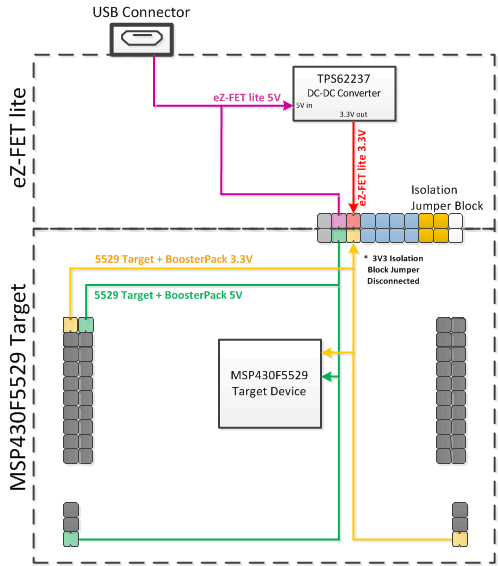SLAU533D September 2013 – April 2017
-
MSP430F5529 LaunchPad™ Development Kit (MSP‑EXP430F5529LP)
- Trademarks
- 1 Getting Started
- 2
Hardware
- 2.1 Block Diagram
- 2.2
Hardware Features
- 2.2.1 MSP430F5529
- 2.2.2 eZ-FET lite Onboard Emulator
- 2.2.3 Integrated Full-Speed USB Hub
- 2.2.4 Power
- 2.2.5 Clocking
- 2.2.6 Application (or "Backchannel") UART
- 2.2.7 Emulator and Target Isolation Jumper Block
- 2.2.8 Isolation Jumper Block: 3.3-V and 5-V Jumpers
- 2.2.9 Isolation Jumper Block: Emulator Connection and Application UART
- 2.3 Measure Current Draw of MSP430 MCU
- 2.4 Using an External Power Source
- 2.5 Using the eZ-FET lite Emulator With a Different Target
- 2.6 USB BSL Button
- 2.7 BoosterPack Plug-in Module Pinout
- 2.8 Design Files
- 2.9 Hardware Change Log
- 3
Software Examples
- 3.1 MSP430 Software Libraries: driverlib and the USB API
- 3.2 Viewing the Code
- 3.3 Example Project Software Organization
- 3.4 USB Configuration Files
- 3.5 Out-of-Box Experience: emulStorageKeyboard
- 3.6 Example: simpleUsbBackchannel
- 3.7 Starting Device Manager
- 4 Additional Resources
- 5 FAQs
- 6 Schematics
- Revision History
2.4.1 External 3.3-V Power Source
It is often beneficial to evaluate the LaunchPad development kit with an external power source (see Figure 18). To see accurate system power when performing this action, it is best to disconnect all jumpers in the isolation block, so that additional power is not consumed by back-powering the emulation MCU through its I/Os. The 5-V jumper can be left populated for proper USB operation and to allow for 5 V to the target side.
 Figure 18. Power Block Diagram for External 3.3-V Power Source
Figure 18. Power Block Diagram for External 3.3-V Power Source - Disconnect the 3V3 jumper in the isolation jumper block. This should be done regardless of 5-V source (external or USB), to avoid conflict with the eZ-FET lite 3.3-V rail.
- If the target voltage to be applied is anything other than exactly 3.3 V, remove the SBW and SBW TST jumpers. The emulator always runs at 3.3 V, and allowing the emulator to communicate with the target when their voltages are significantly different results in back-powering and possible unexpected behavior.
- Apply the external power source to any appropriate location. This includes the 3V3 pin on the right-side power header or directly to the 3V3 BoosterPack plug-in module header pin.
Step 2 requires that emulation is not possible if you are using an external power source at a voltage other than 3.3 V. But USB can be used under these conditions, because there is no connection between the USB module VBUS and VUSB rails and the DVCC and AVCC rails used by the rest of the F5529.